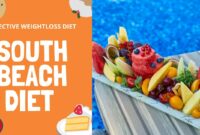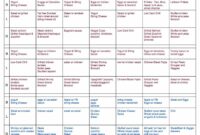Foods to Eat on South Beach Diet: This guide delves into the heart of this popular weight-loss plan, exploring the permitted foods and offering insights into its principles. We’ll uncover the secrets behind the South Beach Diet’s success, examining its phases, allowed food groups, and nutritional benefits. Understanding which foods are encouraged and which are restricted is key to successfully navigating this dietary approach.
From lean proteins and healthy fats to an array of colorful fruits and vegetables, we’ll provide a comprehensive overview of the South Beach Diet’s food choices. We’ll also address common concerns and misconceptions, providing practical tips and advice to make your journey smoother and more enjoyable. This guide aims to empower you with the knowledge to make informed decisions about your diet and overall well-being.
South Beach Diet Principles
The South Beach Diet is a low-carbohydrate diet that emphasizes healthy fats and lean proteins while restricting certain carbohydrates. Unlike some restrictive low-carb diets, it focuses on the *type* of carbohydrates consumed, prioritizing those with a lower glycemic index (GI) to promote stable blood sugar levels and prevent insulin spikes. This approach aims for sustainable weight loss and improved overall health.
Core Tenets of the South Beach Diet
The South Beach Diet’s core tenets revolve around making informed carbohydrate choices and emphasizing nutrient-dense foods. It discourages refined carbohydrates and processed foods, focusing instead on whole grains, lean proteins, and healthy fats. The diet also emphasizes portion control and regular physical activity to support weight loss and overall well-being. The core principle is to improve metabolic health through dietary changes rather than simply restricting calories.
Phases of the South Beach Diet
The South Beach Diet is structured into three phases, each with progressively less restrictive guidelines.
Phase 1, lasting two weeks, is the most restrictive. It eliminates most carbohydrates, including bread, pasta, sugary drinks, and many fruits. The focus is on lean protein, healthy fats, and non-starchy vegetables. This phase aims to jumpstart weight loss and improve insulin sensitivity.
Phase 2, which can last for several weeks or months, gradually reintroduces healthy carbohydrates like whole grains and certain fruits. The emphasis remains on making healthy choices and avoiding processed foods and refined carbohydrates. This phase helps maintain weight loss and build sustainable eating habits.
Phase 3 is the maintenance phase. It encourages continued healthy eating habits developed in Phase 2, allowing for more flexibility while maintaining weight loss. This phase emphasizes long-term lifestyle changes to support continued weight management.
Comparison to Other Low-Carb Diets
The South Beach Diet differs from other low-carb diets like the Atkins diet or ketogenic diet in its approach to carbohydrate restriction. While all three limit carbohydrates, the South Beach Diet emphasizes the *quality* of carbohydrates consumed, allowing certain healthy options in later phases. The Atkins diet, for instance, is more restrictive initially, allowing for a greater increase in carbohydrates only after significant weight loss. The ketogenic diet focuses on very low carbohydrate intake to induce ketosis, a metabolic state where the body burns fat for energy. The South Beach Diet avoids the extreme restrictions of keto, focusing on a more balanced approach.
Allowed and Restricted Food Groups in Each Phase
| Phase | Allowed Food Groups | Restricted Food Groups |
|---|---|---|
| Phase 1 | Lean protein (fish, poultry, beans), healthy fats (avocado, nuts, olive oil), non-starchy vegetables (broccoli, spinach, peppers) | Sugary drinks, bread, pasta, rice, most fruits, processed foods, potatoes |
| Phase 2 | All foods allowed in Phase 1, plus whole grains (oatmeal, quinoa), some fruits (berries), legumes (in moderation) | Processed foods, refined carbohydrates, sugary drinks, high-GI fruits (bananas, mangoes) |
| Phase 3 | Most foods in moderation, emphasis on whole, unprocessed foods | Highly processed foods, excessive amounts of unhealthy fats and sugars |
Foods Allowed on the South Beach Diet
The South Beach Diet emphasizes nutrient-rich foods that promote healthy blood sugar levels and weight management. This approach prioritizes lean proteins, healthy fats, and plenty of non-starchy vegetables and fruits, while limiting processed foods, sugary drinks, and refined carbohydrates. Following these guidelines helps to control hunger and cravings, leading to sustainable weight loss and improved overall health.
Recommended Fruits and Vegetables
Fruits and vegetables form the cornerstone of the South Beach Diet, providing essential vitamins, minerals, and fiber. Prioritizing low-glycemic fruits and vegetables helps regulate blood sugar and prevent energy crashes. The diet encourages a wide variety of colorful options to ensure a balanced intake of nutrients.
- Low-Glycemic Fruits: Berries (strawberries, blueberries, raspberries), avocados, lemons, limes.
- Non-Starchy Vegetables: Leafy greens (spinach, kale, lettuce), broccoli, cauliflower, asparagus, peppers, zucchini, mushrooms.
Suitable Protein Sources
Lean protein sources are crucial for satiety and maintaining muscle mass during weight loss. The South Beach Diet recommends choosing proteins that are low in saturated fat.
- Lean Meats: Chicken breast, turkey breast, fish (salmon, tuna, cod), lean cuts of beef.
- Other Protein Sources: Eggs, beans (kidney, black, pinto), lentils, tofu, Greek yogurt.
Healthy Fats Permitted on the Diet
Healthy fats are an integral part of the South Beach Diet, providing sustained energy and supporting overall health. These fats are essential for hormone production and nutrient absorption.
- Monounsaturated Fats: Olive oil, avocados, nuts (almonds, walnuts, pecans).
- Polyunsaturated Fats: Fatty fish (salmon, tuna), flaxseeds, chia seeds.
Whole Grains on the South Beach Diet
While the initial phase of the South Beach Diet restricts many grains, whole grains are gradually reintroduced in later phases. The focus remains on low-glycemic options that don’t cause rapid spikes in blood sugar. This controlled introduction helps to maintain healthy blood sugar levels and prevent weight gain.
- Permitted Whole Grains (Later Phases): Quinoa, brown rice, whole-wheat bread (in moderation).
Sample One-Day Meal Plan
This sample meal plan demonstrates a balanced approach to the South Beach Diet, emphasizing lean proteins, healthy fats, and non-starchy vegetables. Portion sizes should be adjusted based on individual caloric needs and activity levels.
| Meal | Food Items |
|---|---|
| Breakfast | Scrambled eggs with spinach and a small avocado |
| Lunch | Grilled chicken salad with mixed greens, tomatoes, cucumbers, and a light olive oil vinaigrette |
| Dinner | Baked salmon with roasted broccoli and a small serving of quinoa |
| Snacks | A handful of almonds, berries |
Last Point
Embarking on the South Beach Diet requires a commitment to mindful eating and a focus on nutritious, whole foods. By understanding the principles of this diet and incorporating the recommended foods into your daily meals, you can pave the way for a healthier lifestyle. Remember that consistency and moderation are key, and seeking professional advice before starting any new diet is always recommended. This guide provides a foundational understanding, but individual needs may vary, highlighting the importance of personalized dietary plans.




